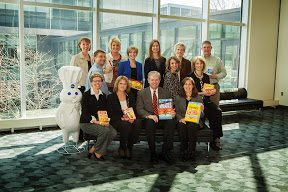A company can have the best strategy in the world, but with a mediocre and untrained workforce, success may be hard to come by.
“You still need to have great strategy, great execution,” said Kevin Wilde, vice president of organization effectiveness and chief learning officer for General Mills. “But talent is such a lever. There’s a heritage and a legacy from our CEO on down that just believes in this and holds the learning department accountable for bringing relevant and great things forth every year.”
Setting a workable learning agenda begins with business partner relationships. They must know that learning leaders understand their problems, their strategy and visions for growth that can translate those into needed capabilities.
General Mills, for instance, has a council of learning leaders embedded in the supply chain, leadership team, sales and other functions. Wilde has primary responsibility for talent and leadership development.
“If it’s the functional skills, that is the supply chain learning leader or the sales learning leader defining what’s necessary, pulling from the center resources as they need it and then executing things within the function on a global basis,” Wilde said. “It’s quality and regulatory training in China to make sure we’ve got food safety in our products. It’s supply chain in Cedar Rapids. It’s making sure we’ve got new ideas on productivity so we can reduce costs and then reinvest in brand building.”
Many learning services happen digitally. General Mills does a great deal of brand building, for instance, to ensure consumers can identify with its different brands — like Yoplait or the newly acquired Yoki in Brazil.
Wilde said in the past brand building was about television and newspapers. With the explosion of digital, the business has to adapt because consumers learn as much on blogs as they do via deliberate marketing channels, and in real time. Strategies may have to change quickly based on what’s happening on the Internet that week.
“If that’s how the role changes, then the competencies need to be tweaked, and your training needs to emphasize different things,” Wilde said. “I work with great colleagues so it’s fun to see where they invent things. I can’t say all the genius comes from the center. Part of my role is to figure out what other people are doing great and bring it around, whether that great stuff is in China, Brazil or here in Minneapolis.”
Wilde also is the co-owner of General Mills’ social collaboration website, “Connect,” along with the head of information technology. Connect has brought significant value in terms of peer-to-peer learning. Two years into the project, Wilde said the company has produced valuable stories of people bringing new products to life because they connected through the website in ways they might not have otherwise.
“At the end of the day, my vision is when people log into work every day they’re logging into our social site. It’s their primary portal and everything else comes off of that,” Wilde said. “We’re not there yet, but that’s where I’m headed.”
The company also has an interesting view on learning metrics and measurement. Wilde described General Mills’ learning measurement strategy as evolving, pointing to one measure that has had tremendous value thus far.
Called Holistic Margin Management (HMM), the strategy began several years ago with the idea of applying Lean Six Sigma tools to combat increasing and volatile commodities costs. The more the company has to pay for an ingredient used to make its products, the less it can do in terms of brand building, marketing or research and development for new products.
“Every year, we are providing another level of training to people involved in our products, whether it’s producing it, selling it or thinking about the next one,” Wilde said. “And every year coming out of that training and the application are fabulous stories that unlock dollars or value to the consumer.”
The savings are counted at an annual supply chain conference and typically exceed millions of dollars. Wilde said if one traces the money back to the source, it begins with training. Training provides the tools, inspiration and support employees need to produce productivity innovations.
Wilde said HMM is such a competitive advantage he can’t share some of the things that are taught.
“I admire people that do Kirkpatrick 1, 2, 3 sorts of things,” Wilde said. “But, ultimately, if you’ve got a leader that understands what learning and development is bringing to the party, you’re measuring it to make sure it’s having a great impact and good things happen in terms of new brands or financial resources — I’m very happy with that, and it works for us here.”















